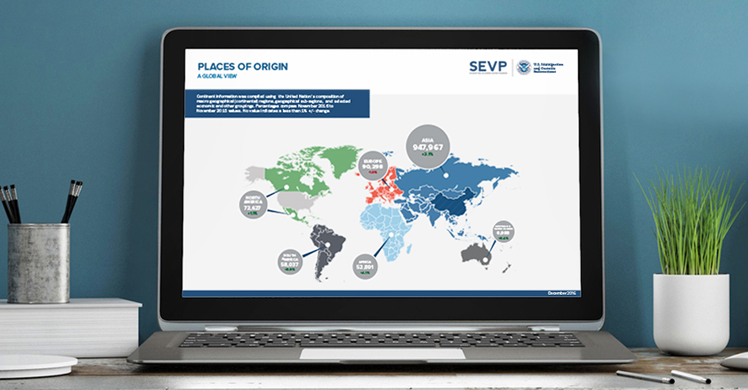ICE publishes quarterly international student data
WASHINGTON — There are 1.23 million international students with F (academic) or M (vocational) status studying at 8,697 schools in the United States according to the latest "SEVIS by the Numbers." This quarterly report on international student trends is prepared by the Student and Exchange Visitor Program (SEVP), part of U.S. Immigration and Customs Enforcement’s (ICE) Homeland Security Investigations (HSI).
The report, released Thursday by SEVP, highlights November 2016 data from the Student and Exchange Visitor Information System (SEVIS), a web-based system that includes information about international students, exchange visitors and their dependents while they are in the United States.
Based on data extracted from SEVIS Nov. 7, the international student population increased 2.9 percent compared to November 2015, but the number of SEVP-certified schools decreased one percent during the same timeframe. California, New York and Texas had the highest international student enrollment in the United States, with the largest number of students in these states coming from China, India and South Korea. International students in these states chose to major in business and engineering more than any other field of study.
Arkansas and Alabama saw the highest percentage increases in international student enrollment compared to the previous year, at 14 and 13 percent, respectively.
Seventy-six percent of all international students studying in the U.S. pursued bachelor’s, master’s or doctoral degrees. California, New York, Texas and Massachusetts were the top states for enrollment at these educational levels. When compared to the previous year, the following states saw the most notable percentage growth in international students pursuing higher education degrees: international students pursuing bachelor’s degrees in Alabama increased 13.3 percent, international students pursuing master’s degrees in Virginia increased 21.4 percent, and international students pursuing doctoral degrees in Oregon increased 20.5 percent.
Nearly 42 percent of all F and M students pursued studies in science, technology, engineering and mathematics (STEM) fields. This marks a 10.1 percent increase in international students pursuing STEM studies compared to November 2015.
Out of the nearly 514,000 international students pursuing STEM studies, almost 450,000 were from Asia, with the majority of all STEM students from India and China. While only 1,288 international students from Australia and the Pacific Islands pursued STEM studies in the U.S., this geographic area had the largest percentage growth among STEM students at 15 percent.
The top three states for both overall international student enrollment and STEM student enrollment were California, Texas and New York. Over the last five years, the number of overall international students increased 49 percent in California, 34.5 percent in Texas and 30.3 percent in New York. The number of STEM students increased 103.8 percent in California, 79.3 percent in Texas and 68.2 percent in New York during the same timeframe. Connecticut, Massachusetts and Virginia saw especially notable growth in STEM students compared to November 2015, at 20 percent, 14 percent and 17 percent respectively.
Among U.S. schools, New York University, the University of Southern California, Northeastern University, Columbia University, and Arizona State University had the largest international student populations. More than 11,500 international students enrolled at each school in November.
Report data was extracted from SEVIS Nov. 7. The report captures a point-in-time snapshot of data related to international students studying in the United States. Data for the previous "SEVIS by the Numbers" report was extracted from SEVIS in July 2016.
Individuals can explore more international student data from current and previous "SEVIS by the Numbers" reports by visiting the Study in the States interactive mapping tool. This information is accessible at the continent, region and country level and includes information on gender and education levels, as well as international student populations by state, broken down by geographical areas across the globe.
SEVP monitors more than one million international students pursuing academic or vocational studies (F and M visa holders) in the United States and their dependents. It also certifies the schools and programs that enroll these students. The U.S. Department of State monitors exchange visitors (J visa holders) and their dependents, and oversees exchange visitor programs.
Both SEVP and the Department of State use SEVIS to protect national security by ensuring that students, visitors and schools comply with U.S. laws. SEVP also collects and shares SEVIS information with government partners, including U.S. Customs and Border Protection and U.S. Citizenship and Immigration Services, so only legitimate international students and exchange visitors gain entry into the United States.
HSI reviews SEVIS records for potential violations and refers cases with possible national security risks or public safety concerns to its field offices for further investigation. Additionally, SEVP’s Analysis and Operations Center reviews student and school records for administrative compliance with federal regulations related to studying in the United States.


